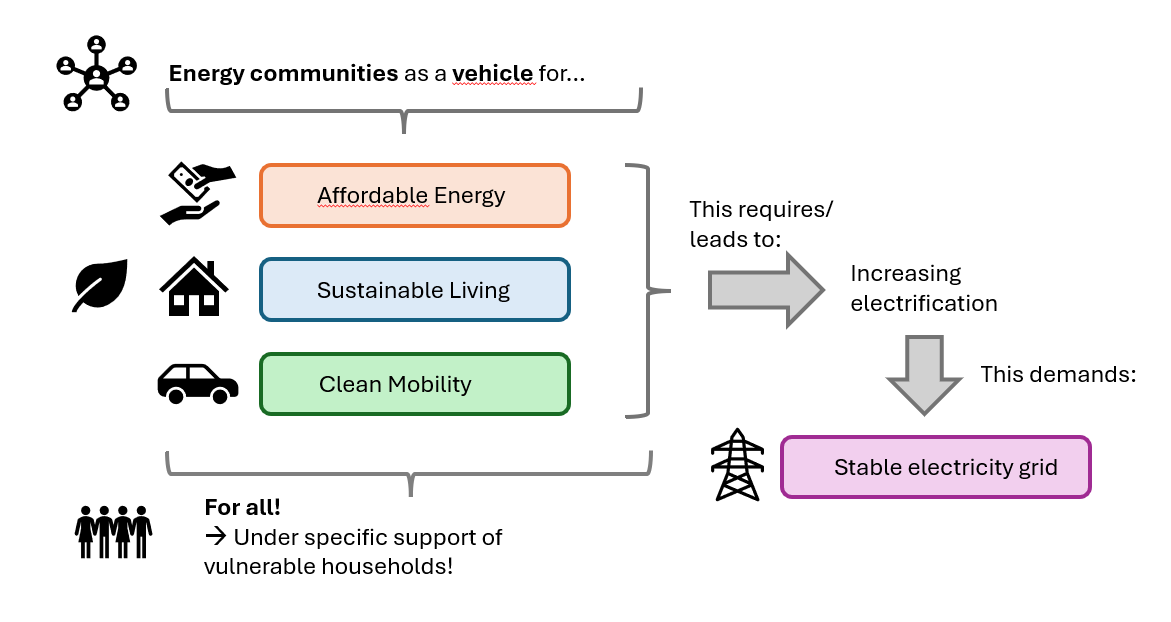DESIREE - Decarbonisation and fighting energy poverty through energy communities
Short Description
Starting point / motivation
How energy communities can serve as a vehicle for various goals:
- Affordable energy
- Sustainable living
- Clean mobility
This applies to everyone, with particular support for vulnerable households.
These goals lead to increasing electrification, which in turn requires a stable electricity grid.
Contents and goals
To ensure affordable energy for all, special offers can be designed for ECs with the goal to financially support vulnerable participants in particular (e.g. methods to redistribute savings).
Thereby, it must also be evaluated which share of vulnerable households can realistically be integrated into ECs from an economic perspective, so that it is ensured that all (other) participants still continue to benefit financially. Sustainable and socially responsible investment decisions (ESG investing) are also analysed with regard to their potential in ECs.
Methods
In order to achieve a socio-economic optimum in the long term, ECs should be considered as one joint entity rather than a collection of individuals. The "community-as-a-whole" approach is quantified from a financial perspective and implemented in practice as an "Energiekonto".
ECs could be a vehicle for increasing refurbishment rates, which would enable sustainable housing. For that, however, awareness of ECs' existence needs to be raised. The contribution potential of property management companies, having access to residents and building owners, shall be assessed and attractive business models are developed to unlock their potential.
ECs also have the potential to help incentivise heating system changes. A change from gas to electric heating systems becomes easier even for vulnerable households thanks to cheaper EC electricity. In this context, the cost- and emission-saving potential is to be quantified.
Furthermore, socially just CO2 pricing mechanisms are developed. Another innovative way to reduce emissions was initiated by Sozialbau through an apartment exchange program that enables residents to swap apartments and thus keep commutes short. The so-avoided emissions will be quantified and the potential to roll-out such concepts at a large-scale within ECs assessed.
Expected results
Multiple-EC-participation brings new opportunities for sustainable mobility. EC memberships (and corresponding routes) can be strategically planned with regard to charging opportunities, as can internal EC charging infrastructure.
It is necessary to determine
- whether these new opportunities are competitive with conventional charging providers' offers and
- whether it would also be legally possible for ECs to 'share' existing charging infrastructure of conventional operators (incl. business model development).
Innovative E-car sharing models are investigated taking into consideration the tension-field between conventional operators, vulnerable and non-vulnerable customers. In addition, a 'charging-EC' will be implemented in practice in order to promote centralized EC charging infrastructure (instead of private charging points) - including corresponding incentive mechanisms.
With increasing electrification, the burden of the electricity grid is also increasing, which is why the issue of stable electricity grid operation becomes more and more critical. Capacity bottlenecks in the electricity grid, the resulting costs and how these are passed on to grid tariffs, as well as the effects on vulnerable groups in particular, are being analyzed and socially-responsible tariff designs developed.
Project Partners
Project management
AIT Austrian Institute of Technology GmbH
Project or cooperation partners
- Sozialbau AG
- Energie Kompass GmbH
- Ivalu
- E-Mobilitätszentrum 4u GmbH
- Limotus
- Future.lab
Contact Address
AIT Austrian Institute of Technology GmbH
Giefinggasse 4
A-1210 Vienna
Tel.: +43 (664) 883 900 46
E-mail: bernadette.fina@ait.ac.at
Web: www.ait.ac.at

